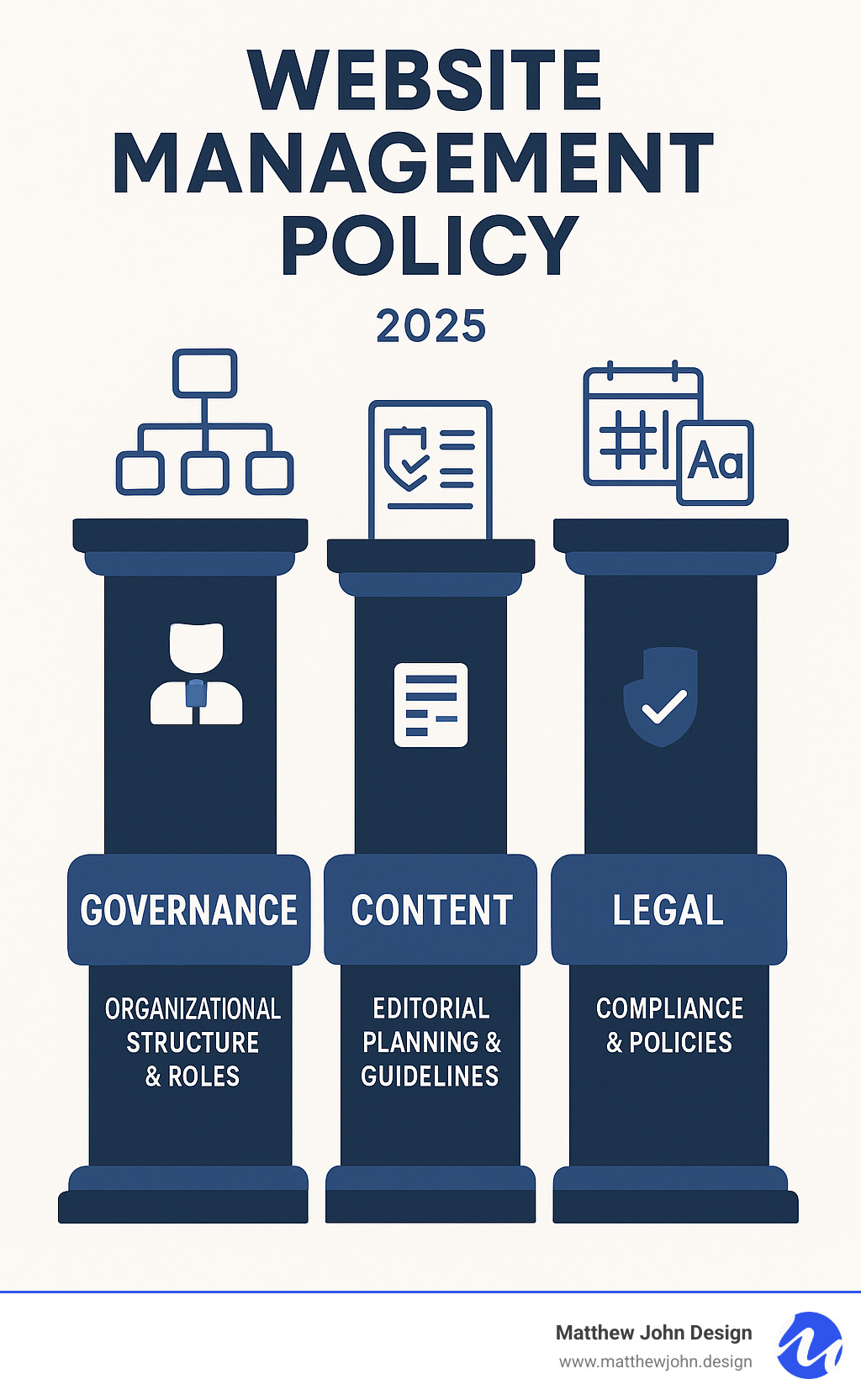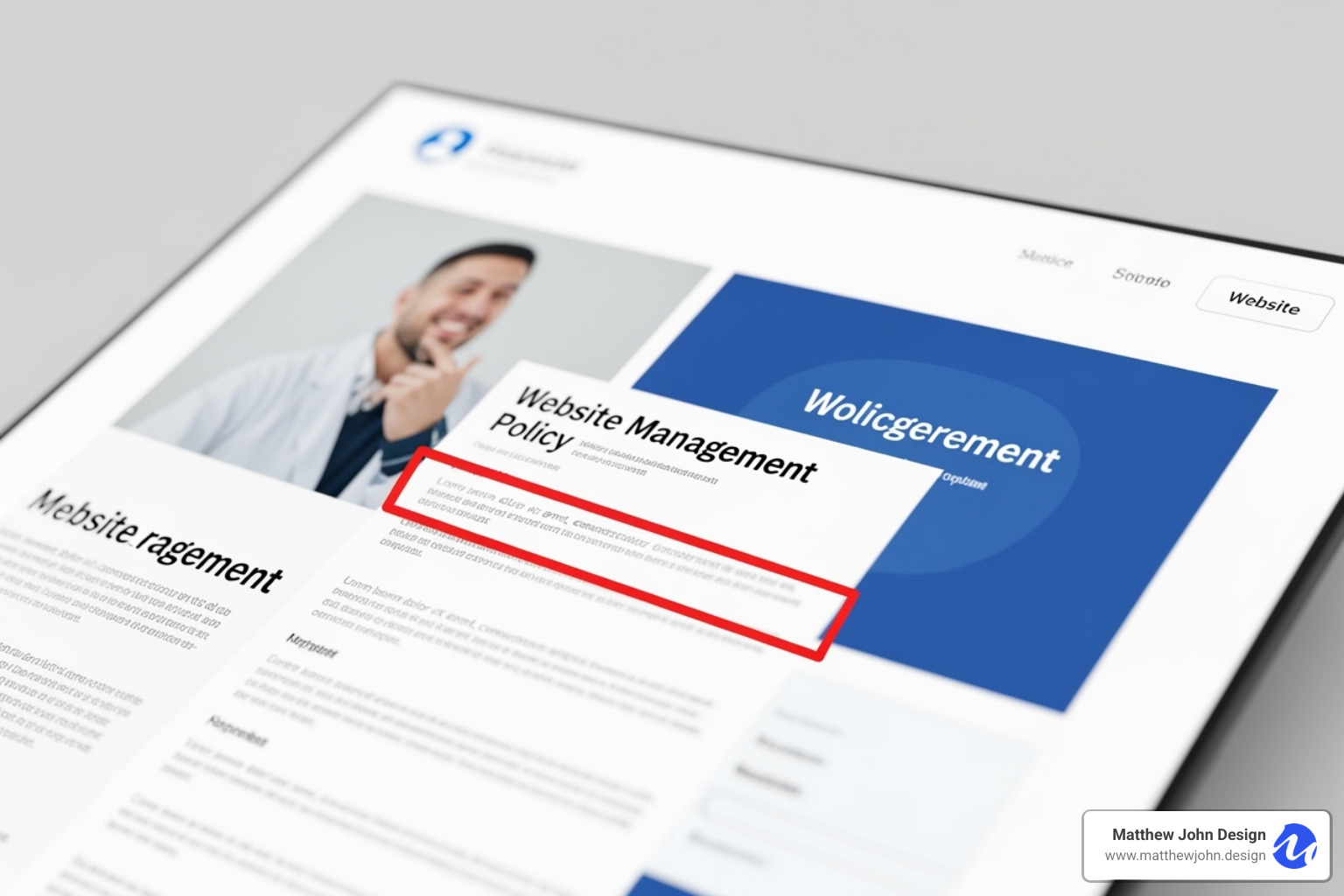Any information contained on this Website is not legal advice and should not be treated as such. You should always contact an attorney for help with your specific legal needs and issues. We may also earn a commission when you click links to our partners and purchase goods or services. For more information, read our Disclaimers Policy.
Why Every Business Needs a Website Management Policy Template
A website management policy template is a structured document that outlines the rules, procedures, and responsibilities for managing your website's operations, content, and security. It serves as the foundation for consistent site management and protects your business from legal, technical, and operational risks.
Key components of a website management policy template:
- Governance structure - Defines roles like Web Administrator, Webmaster, and Content Editors
- Content guidelines - Establishes brand voice, approval workflows, and publishing standards
- Technical protocols - Covers security measures, backup procedures, and performance monitoring
- Legal compliance - Ensures adherence to privacy laws, accessibility standards, and terms of service
- Review processes - Sets schedules for policy updates and staff training requirements
According to research from the W3C and government agencies, businesses without clear website management policies face significant risks. GDPR fines alone can reach up to 4% of annual revenue or €20 million for non-compliance. Beyond legal penalties, poorly managed websites suffer from inconsistent branding, security vulnerabilities, and operational inefficiencies that damage user trust and SEO rankings.
Your website is often the first impression customers have of your business. A well-structured policy ensures every team member knows their responsibilities, maintains quality standards, and protects your digital assets. This creates a seamless experience for visitors while streamlining internal workflows.

Why Your Business Needs a Website Management Policy
Operating a website without a clear management policy is like running a store with no rules—it's inefficient, risky, and unprofessional. Your website is a vital business asset, and a strong website management policy template is essential to protect it.
Here’s why it's so critical:
Builds Trust and Protects Data: A policy clarifies how you protect sensitive user and business data. This transparency builds user trust, which is crucial when nearly half of users have stopped buying from a company over privacy concerns. A clear policy shows you value their security.
Strengthens Brand and SEO: Your website is a direct reflection of your brand. A policy ensures consistency in your content, design, and messaging, preventing a disjointed user experience. This quality focus, along with technical guidelines for security and performance, also boosts your SEO rankings.
Ensures Stability and Efficiency: What happens if a key team member leaves or your site crashes? A policy documents all critical procedures, ensuring business continuity and smooth recovery. It also defines roles and workflows, eliminating guesswork, reducing errors, and saving valuable resources.
Without a clear website management policy template, you face serious risks:
- Inconsistent Branding: A messy, unprofessional look that confuses customers.
- Security Vulnerabilities: An open door for cyberattacks, leading to data breaches and downtime.
- Wasted Resources: Inefficient workflows and duplicated efforts drain time and money.
- Legal Liability: This is the biggest risk. Failing to comply with regulations like GDPR can lead to massive fines—up to 4% of annual revenue or €20 million for GDPR alone. Many third-party tools like Google Analytics also require you to have specific policies in place.
A strong policy isn't just about avoiding problems; it's a foundation for growth. If you're ready to build that foundation, Matthew John Design offers comprehensive Website Management Services to guide you.
The Essential Components of a Comprehensive Website Management Policy Template
Now that we understand why a website management policy template is crucial, let's break down its essential components. This blueprint ensures every aspect of your website's operation is covered.
Governance & Roles: The Foundation of Your Policy
Clearly defined roles prevent confusion and ensure accountability. Your policy should outline the team responsible for the website.
- Web Administrator: Oversees the entire website operation, compliance, and quality.
- Webmaster: Manages technical performance, security, and site integrity.
- Web Editors: Create, update, and proofread content for their respective departments.
- Department Heads: Oversee their editors and approve departmental content.
- Executive Leadership: Approves major strategic or policy changes to the website.
This section should also define approval workflows and policy enforcement. For a real-world example, see the W3C's guide on organizational policies.
Content Strategy in Your Website Management Policy Template
Your content is your brand's voice. A content strategy ensures it remains consistent, high-quality, and effective.
- Guidelines: Define your brand voice, tone, style, and SEO best practices.
- Workflows: Establish a clear cycle for content review, approval, and publishing.
- Maintenance: Create rules for archiving or removing outdated content to keep the site relevant.
- User-Generated Content: If applicable, outline rules for moderation and use.
For more on this, check out our Webflow Website Management Article.
Technical & Security Guidelines
A solid technical foundation keeps your site running smoothly and securely.
- Backups & Updates: Detail your schedule for website backups and software updates.
- Security: Mandate strong passwords, two-factor authentication (2FA), and performance monitoring.
- Continuity: Define uptime goals and create a disaster recovery and data breach incident response plan.
Platforms like Webflow have robust built-in security, but strong internal practices are still vital. Our Website Support Subscription Services can help manage these technical aspects.
Legal & Compliance Framework
This section ensures you meet all legal requirements and build user trust. Your internal policy must mandate the creation and display of several public-facing legal documents.

- Required Policies: Your site must have a Privacy Policy (detailing data handling per regulations like GDPR), a Cookie Policy, Terms of Service, and Disclaimers.
These documents are non-negotiable for legal compliance. We offer a suite of All Website Policies and a Privacy Declaration Template Article to help you start.
Website Accessibility Standards
An accessible website is a legal and moral imperative. Your policy should state your commitment to inclusivity.
- Standards: Specify your target Web Content Accessibility Guidelines (WCAG) conformance level (e.g., AA) to comply with laws like the Americans with Disabilities Act (ADA).
- Processes: Create channels for user feedback on accessibility and schedule regular accessibility audits.
For more guidance, the W3C offers excellent resources on Developing Organizational Policies on Web Accessibility.
Implementation and Maintenance: Putting Your Policy into Practice
A website management policy template is a living document. Creating it is the first step; the next is to bring it to life through implementation, communication, and regular maintenance. This is the core of effective policy lifecycle management.
Displaying Your Policies for Accessibility and Compliance
For your policies to be legally effective, users must be able to find them easily. Hiding them defeats the purpose.
- Prominent Locations: Place clear links to your Privacy Policy, Terms of Service, and other legal documents in your website footer—the standard and expected location.
- Key Touchpoints: Also, link to relevant policies on user registration forms, e-commerce checkout pages, and within cookie consent banners. This ensures users see them at critical moments.
Policy Review and Update Cadence
The digital world changes constantly, and your policy must keep up. A "set it and forget it" approach is not an option.
- Scheduled Reviews: Commit to an annual review of your entire policy to ensure it remains accurate and relevant.
- Trigger Events: Update your policy immediately following new laws or regulations, significant changes in business operations, or the implementation of new technology that affects data handling or security.
- Communication: Establish a process for notifying users of significant policy changes and conduct regular staff training to ensure everyone understands their responsibilities.
Using a Template vs. Custom Drafting
You can start with a pre-made template or draft a policy from scratch. The right choice depends on your business's complexity, budget, and needs.
| Feature | Using a Template / Generator | Custom Drafting |
|---|---|---|
| Cost | Lower initial cost. | Higher cost due to legal fees. |
| Speed | Quick to set up. | Time-consuming process. |
| Coverage | General; may miss unique business needs. | Comprehensive and custom to your exact operations. |
| Best For | Startups, small businesses, or those with standard operations. | Complex businesses, companies in high-risk industries, or those with unique data practices. |
A hybrid approach—starting with a quality template and customizing it with legal guidance—often provides the best balance of cost, speed, and protection.
Quick Recap: Core Components at a Glance
A comprehensive website management policy template rests on five interconnected pillars:
- Governance - clear role definitions and approval workflows.
- Content Strategy - brand-aligned guidelines, SEO best practices, and a maintenance plan.
- Technical & Security - backups, updates, uptime targets, and incident-response playbooks.
- Legal Compliance - Privacy Policy, Cookie Policy, Terms of Service, and required disclaimers.
- Accessibility - commitment to WCAG conformance, regular audits, and user feedback channels.
When these elements work together, your policy becomes a practical blueprint for a secure, compliant, and consistently on-brand website.
Quick Recap: From Policy to Practice
Creating the document is only the first step. Real value comes from implementation:
- Visibility - link legal policies in the footer, on sign-up forms, checkout pages, and within cookie banners.
- Continuous Improvement - schedule an annual review and update immediately after legal, technical, or business changes.
- Training & Accountability - make sure every team member understands their responsibilities, from Web Administrator to content editors.
- Template vs. Custom - start with a trusted template for speed and cost-efficiency, then tailor it (with legal guidance if needed) to cover your specific operations.
With these practices in place, your website management policy template evolves into a living system that safeguards your site and streamlines day-to-day management.
Frequently Asked Questions about Website Management Policies
We've covered a lot of ground on the website management policy template. Here are answers to a few common questions.
What is the difference between a Website Management Policy and a Privacy Policy?
Your Website Management Policy is a broad, internal document for your team, covering all site operations like roles, content workflows, and security protocols. A Privacy Policy is a specific, public-facing legal document explaining how you collect, use, and protect user data. The management policy mandates that you must have a public privacy policy.
Can I just copy a policy from another website?
No. Copying a policy is a copyright risk and, more importantly, it won't match your unique business operations, data practices, or technology stack. This can leave you non-compliant and unprotected. Your policies must be accurately customized for your business.
Who is responsible for enforcing the website management policy?
Enforcement is a team effort. A designated Web Administrator or IT Director typically oversees the policy, but department heads, managers, and every team member involved with the website are responsible for following the guidelines in their specific roles. The policy itself should clearly define this structure.
Conclusion
We've journeyed through the website management policy template, and it's clear how vital this document is. It's the guardian of your online presence, ensuring security, consistency, and legal compliance.
A comprehensive policy is a living guide that empowers your team, reduces risk, and streamlines operations. It's not a static document you create once and forget.
Here at Matthew John Design, we build scalable Webflow sites with component-based systems that are easy for internal marketing teams to manage. A clear website management policy template makes that process even smoother.
Ready to take control of your website's future? Let us help you put the right policies in place for a secure, compliant, and consistently excellent digital presence. You can always Get professional help with your Website Policies from our team.



